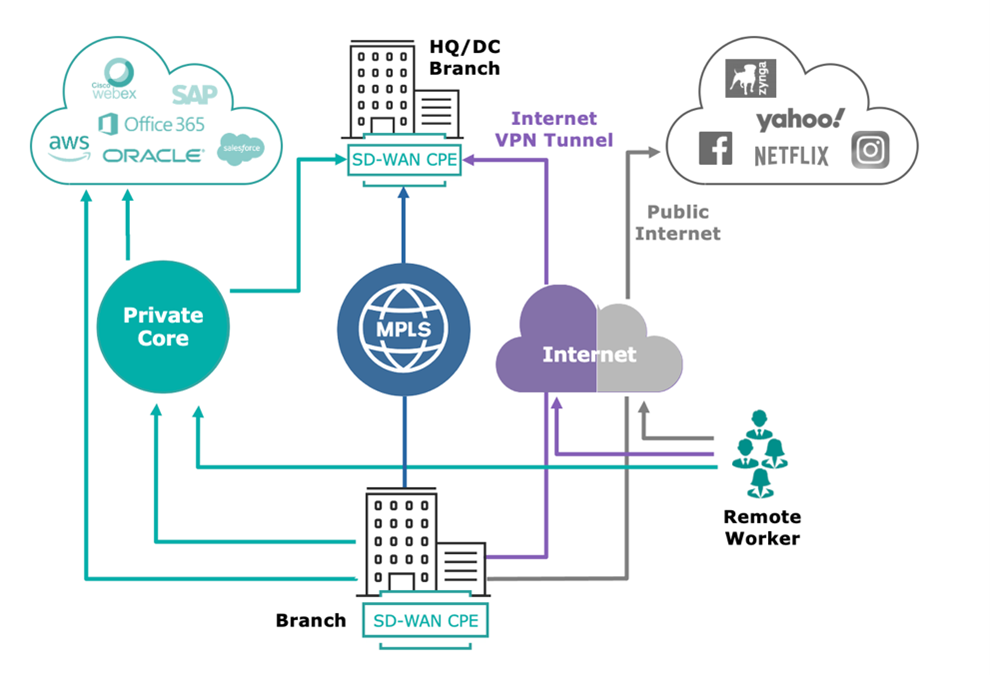Moving from MPLS to SD-WAN is a natural next step for many businesses. Businesses must adopt efficient and reliable networking solutions to cope with changing dynamics. This is more true with the rising trend of remote working and data increasingly becoming king.
And while the process of transitioning to SD-WAN might seem complex and daunting, it can be pretty simple with proper planning. The thing is, you need to prepare so that you can have a successful transition adequately. This article dives into the key considerations when transitioning from MPLS to SD-WAN.
What is MPLS?
MPLS is the short form for Multi-Protocol Label Switching. It is a networking solution that uses labels on packets to route traffic. It connects endpoints and users from remote branches to the firm’s data center. With MPLS, an organization can connect its branches to the private network to use applications hosted at the headquarters.
Unlike other solutions like VPNs that rely on IT staff for maintenance, MPLS is managed by the carrier. This feature frees up time for the IT experts and pressures the carrier to provide excellent quality of service (QoS).
What is SD-WAN?
Software-defined wide area network (SD-WAN) is a modern networking technology that leverages software and the cloud to relay traffic. It provides a centralized point to control and monitor data traffic intelligently depending on the enterprise’s needs.
Businesses are transitioning to SD-WAN as it addresses the challenges posed by conventional networks like MPLS. The goal of shifting to SD-WAN is to increase business efficiency and productivity. Some of the benefits that justify the shift include:
- Flexibility to scale
- Cloud-readiness
- Increased network agility
- Enhanced security
Factors to Consider When Transitioning From MPLS to SD-WAN
Below are some considerations to make when transitioning from MPLS to SD-WAN.
Network Requirements
One of the key considerations before migrating to SD-WAN is your company’s network requirements. It involves assessing the applications that your business relies on for day-to-day operations. You need to know each application’s bandwidth needs, how often users engage the applications, and the intensity of the tasks they perform. Also, establish the acceptable level of latency for your network’s applications.
Quality of Service (QoS) vs. Quality of Experience (QoE)
It is crucial to understand how QoS differs from QoE before implementing SD-WAN in your organization. MPLS carriers guarantee optimal network performance by dispatching IT experts to manage users’ networks. This guarantee is the Quality of Service (QoS) and seeks to reduce latency and jitter. This commitment to QoS is included in MPLS service level agreements (SLAs).
On the part of SD-WAN, the network administrator establishes some policies to route traffic based on application priority when there is congestion. But unlike QoS, which is a guarantee, QOE doesn’t have a contractual basis.
You should decide how to deal with public network congestion and avoid latency when using SD-WAN.
Type of SD-WAN Provider
When choosing an SD-WAN provider for your business, decide which services best fit your needs. Some providers provide unmanaged services, which means network monitoring, control, and maintenance fall on the service buyer’s shoulders. However, some providers offer managed SD-WAN services that manage some or all aspects of your network. Before moving to SD-WAN, have a clear framework of the managed services and know what your IT experts will handle.
SD-WAN Appliance Considerations
Another factor to consider before transitioning is the provider’s capabilities. Every provider has its strengths that might affect your system performance. Thus, you need to evaluate the network needs of your devices at each branch. Also, check whether the SD-WAN you choose caters to those needs sufficiently. Some key appliance capabilities to consider include:
- Bandwidth capacity
- Power supply redundancy
- Device WAN interfaces
Wrap Up
Transitioning from MPLS to SD-WAN is prudent, but it requires preparation. You need to consider several factors, including your network requirements, QoS, QoE, the type of SD-WAN provider, and appliance capabilities. Getting these factors right will ensure a seamless implementation of SD-WAN and experience better business productivity and success.

